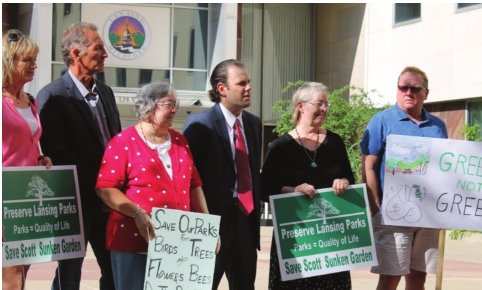A coalition of community members and groups is asking the Lansing City Council to appoint an independent committee to review the plans and costs associated with a controversial power substation plan.
On Monday evening, the Lansing Board of Water and Light once again raised the estimated costs of the project, proposed for the corner of Malcolm X Street and South Washington Avenue, from $26 million to $27.9 million. BWL officials said the increase was to reflect an “apples to apples” comparison of the project with another location.
In February, BWL announced plans to build a new power substation at Scott Park at Malcolm X Street and Washington Avenue. The project has drawn criticism from historic preservationists and neighbors in the historic Cherry Hill Neighborhood nearby.
Also among the critiques is how the city-owned utility is arriving at the shifting cost estimates it is sharing with city leaders and citizens.

City Pulse has documented at least 14 different sets of numbers presented since February by the BWL for a substation at Scott Park or other locations. Monday night, the utility presented a 15th estimate.
“We really need a third party committee to look at the costs,” said Dale Schrader, vice president of Preservation Lansing and part of a coalition that includes Cherry Hill, The Lansing Garden Club and concerned citizens.
City Pulse reported in April that the utility initially placed the cost of maintaining and updating the Eckert substation, instead of a new one, at $39 million. Earlier this month, utility officials told the City Council that retaining the Eckert substation would cost $42 million. That estimate has ballooned to $70 million, according to figures outlined on three separate pages of the utility’s public presentation Monday night.
But even this estimate is controversial.
“The total cost of refurbishing Eckert for seven years beyond its 2020 retirement date is $60 million and is repeated on multiple pages in the PowerPoint, not $70 million as you stated,” BWL spokesman Steve Serkaian said by email to City Pulse Tuesday.
But he said taxpayers would pay an additional $10 million over seven years to service the $60 million.
He said a new cooling water intake structure presented at Monday’s meeting would cost $30 million because of federal environmental requirements, bringing it to $60 million.
The substation reflects BWL’s desire to end all electricity and steam production at the iconic coal-burning Eckert plant by 2020. The current substation is located adjacent to it in the Grand River floodplain.
“Where is the data?” asked James Mc- Clurken, a member of the Lansing Parks Board who opposed the plan when it was before that body earlier this year. “All I see is a PowerPoint.”
Steve Japinga, director of government relations for the Lansing Regional Chamber of Commerce, said his organization would not be opposed to an independent review of the BWL’s cost estimates and plans. The Chamber supports BWL’s proposal.
“I think that was a fair point,” he said by phone Tuesday about the proposed third party review. “I didn’t see in the notations where they arrived at those numbers, and with this type of project, you’d expect to see that on an issue this complex.”
This is not the first time the BWL has been asked to show the data behind its proposed cost estimates.
Last month, Councilwoman Jody Washington, who represents the First Ward, said she wanted to see a spreadsheet of how the cost estimates had been arrived at. Her concern was related to the newly identified Diamond Reo Way location for the substation just behind the BWL. Officials at the utility had said putting the project there would cost ratepayers $13 million, resulting in a 4 percent rate increase for seven years.
But that proposed rate increase, based on numbers previously provided by BWL, would have resulted in raising $70 million — $57 million more than the costs associated with the project.
Washington said BWL still has not provided the spreadsheet she was seeking and on Tuesday she renewed her call.
The Diamond REO Way location was “exhaustively reviewed,” Serkaian said.
The BWL’s presentation to the Council Monday night showed two approaches for transmitting electricity between a Diamond REO substation and downtown Lansing.
One option, rendered dramatically, placed transmission lines on poles up and down Washington and in surrounding neighborhoods.
The presentation caused some in the audience to gasp, and At- Large Councilwoman Patricia Spitzley told BWL officials the images “took me aback.” The cost for the overhead option was slated at $86.4 million, according to the PowerPoint from BWL.
The second option is to run the power underground, which BWL PowerPoint indicated would cost $101.4 million. The route would run across the Grand River and up along the GM property on Townsend Street.
Asked by City Pulse why the utility had presented an underground line plan to the Council that did not use the current underground infrastructure that already runs up Washington Avenue, Serkaian said in an email he did not see any such infrastructure in previous presentations and the route presented was "best route to take relative to best practices."
Ultimately, the consequence of placing the substation at Diamond REO Way, BWL argued, would cause issues with the look and feel of the neighborhood and entail considerable time over-runs as the utility worked to obtain rights to run the power lines along private property or permits to run it under or over the river. This cost would be borne by ratepayers.
Support City Pulse - Donate Today!
Comments
No comments on this item Please log in to comment by clicking here